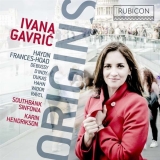 Origins; Haydn: Klavierkonzert H18 Nr. 11; Debussy: Hommage à Haydn; Dukas: Prélude élégiaque; Ravel: Menuet sur le nom d'Haydn; Frances-Hoad: Stolen Rhythm + Between the Skies, the River and the Hills; D'Indy: Menuet sur le nom d'Haydn; Hahn: Thème varié sur le nom de Haydn; Widor: Fugue sur le nom de Haydn; Traditional: Kad ja podoh na Bentbasu; Ivana Gavric, Klavier, Southbank Sinfonia, Karin Hendrickson; 1 CD Rubicon RCD1038; Aufnahmen 2015-2019, Veröffentlichung 27/09/2019 (64'21) - Rezension von Remy Franck
Origins; Haydn: Klavierkonzert H18 Nr. 11; Debussy: Hommage à Haydn; Dukas: Prélude élégiaque; Ravel: Menuet sur le nom d'Haydn; Frances-Hoad: Stolen Rhythm + Between the Skies, the River and the Hills; D'Indy: Menuet sur le nom d'Haydn; Hahn: Thème varié sur le nom de Haydn; Widor: Fugue sur le nom de Haydn; Traditional: Kad ja podoh na Bentbasu; Ivana Gavric, Klavier, Southbank Sinfonia, Karin Hendrickson; 1 CD Rubicon RCD1038; Aufnahmen 2015-2019, Veröffentlichung 27/09/2019 (64'21) - Rezension von Remy Franck
Die aus Sarajevo stammende britische Pianistin Ivana Gavric spielt Joseph Haydns 11. Klavierkonzert mit viel Sachkenntnis und einem äußerst präzisen Spiel. Nie bedauert man dabei, dass Gavric ein modernes Klavier benutzt, im Gegenteil. Das Raffinement, dessen die Interpretin fähig ist, enthält ein Maß an Verspieltheit, an Leichtigkeit, an Nuancen und Kontrasten, die weder am Cembalo noch am Pianoforte möglich wären. Die Southbank Sinfonia erwidert diese Leichtigkeit.
Ganz nachdenklich und dunkel gefärbt erklingen Debussys Hommage à Haydn sowie das Poème élégiaque von Paul Dukas. Ravels Menuett ist schon heller in den Farben, aber immer noch leicht melancholisch, genau wie die restlichen Werke der CD, wobei Widors Fuge das am meisten verspielte Werk ist.
Doch diese Stücke sind nur die Steine im Fluss, die den Weg freimachen zu Cheryl Francess-Hoads Between the Skies, the River and the Hills.
Das 2018 entstandene Werk bezieht seine Quellen aus Haydns Klavierkonzert Nr. 11, einem Volkslied aus Sarajevo und dem Roman Die Brücke über die Drina von Ivo Andric. Der erste Satz ist konfliktreich und leidenschaftlich, der zweite ein tänzerisches Scherzo und der letzte ein Lento lamentoso. Dieses Finale wiederholt das Volkslied Kad ja podoh na Bentbasu (das als die inoffizielle Hymne der Stadt gilt) bis hin zu einem Fortissimo-Höhepunkt und endet mit einer Klavierkadenz.
Eine engagierte Interpretation von Solistin sowie auch vom Orchester lässt das Stück wirkungsvoll werden. Als deskriptiv-romantisches Stück spielt es mit Stimmungen, die die Komponistin aus der Zeitgeschichte bezieht. Die Rolle des oft perkussiv eingesetzten Klaviers ist dabei relativ begrenzt.
The Sarajevo-born British pianist Ivana Gavric plays Joseph Haydn’s 11th Piano Concerto with a great deal of expertise and much precision. One never regrets that she uses a modern piano, on the contrary. The refinement that the pianist is capable of contains a degree of playfulness, lightness, nuances and contrasts that would not be possible on either the harpsichord or the piano. The Southbank Sinfonia agreeably replies to this lightness.
Debussy’s Hommage à Haydn and Paul Dukas’s Poème élégiaque are all thoughtful and dark in colour. Ravel’s minuet is already brighter in colour, but still slightly melancholic, just like the other works on the CD, with Widor’s Fugue being the most playful.
But these pieces are only the stones in the river that open the way to Cheryl Francess-Hoad’s Between the Skies, the River and the Hills.
Composed in 2018 the work draws its sources from Haydn’s Piano Concerto No. 11, a Sarajevo folk song, and Ivo Andric’s novel The Bridge over the Drina. The first movement is conflict-laden and passionate, the second a dance-like scherzo and the last a Lamentoso lento. This finale repeats the folk song Kad ja podoh na Bentbasu (which is considered the unofficial anthem of the city), leading to a fortissimo climax and ends with a piano cadenza.
A committed interpretation by both soloist and orchestra makes the piece effective. As a descriptive-romantic piece, it plays with moods that the composer draws from contemporary history. The role of the piano, often used percussively, is relatively limited
























